The Best Keto-Friendly Vegetables
This recipe may contain Amazon or other affiliate links. As an Amazon Associate I earn from qualifying purchases.
What vegetables are best, and which ones should be avoided on the Ketogenic diet? What are the Keto-friendly vegetables?
This Keto Vegetable List will bring you all the answers you need!
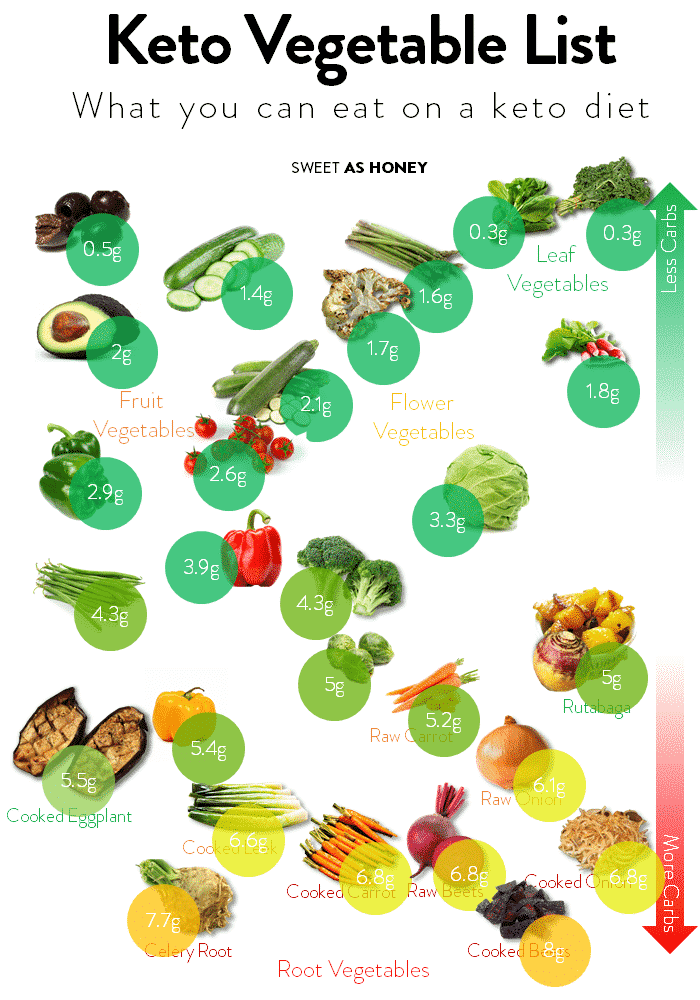
What Vegetable Can I Eat On A Keto Diet?
The first thing to look at in order to find out if a vegetable is keto-friendly is where the vegetable is coming from.
Not the country or region it’s coming from, but rather surprisingly whether it grows above the ground or under the ground.
As a rule of thumb, most above-the-ground vegetables are keto-friendly while most under-the-ground vegetables should be considered very carefully if they could be eaten raw or downright avoided if they are never eaten raw when you follow a keto diet.
Remember that it is all about carbohydrate amounts, but before I list all the vegetables, I’ll remind you that on low-carb diets, we only care about the grams of net carbs.
Net carbs are what’s left when we take away the amount of Fiber from the Total Carbs present in the fruit.
This is because fibers (that are a type of carbs) are not consumed by the body and therefore don’t alter your blood sugar level.
Regardless of carbs, vegetables are essential for a healthy, balanced diet. They bring heaps of vitamins (Vitamin C, Vitamin A), minerals, and antioxidants.
Some vegetables are also a great source of protein, iron, and Vitamin B12 – all essentials for those on a keto vegan diet.
If you don’t know how much net carbs you should get, make sure to check my macro calculator that will tell you what your daily carb, protein, fat, and calorie intake should be to achieve your goals!
You can truly achieve your goals when you know where carbs are coming from, so read on to learn where they are in the common vegetables.
If you would like to find out what keto-friendly fruits are, check out my article on low-carb fruits.
What Are The Different Kinds Of Vegetables?
Vegetables are more a culinary concept than a botanic one. The term vegetable actually only describes the parts of plants that can be consumed by human beings.
It’s easy to understand why some vegetables are more keto-friendly than others when you look at why plants grow vegetables. Plants create vegetables for four main reasons:
- as energy storage, and it’s generally in the form of starch (and thus loaded in carbs) and contains as little water as possible to keep the energy density high. And to keep their storage safe, it’s generally hidden underground. E.g., potato, carrot, beetroot, etc. These are generally NOT keto-friendly.
- as a fruit in order to disperse seeds and allow more of the same plant to grow somewhere else. Since it is meant to be disseminated and also to provide enough water for the seeds to grow, it’s often low in carbs and high in water. E.g., capsicum, cucumber, green beans, etc. These are Keto-friendly if consumed occasionally in moderate amounts.
- as a flower, and therefore it contains almost no reserve of sugar but also not as much water as fruits. E.g., cauliflower, broccoli, etc. These are Keto friendly.
- as a leaf in order for the plant to perform its photosynthesis that is its source of energy – see that as the botanical version of a solar panel. Leaves generally contain very little stored energy (sugar, starch, etc.) because their biggest requirement is to grow fast and cover an area as wide as possible. E.g., lettuce, spinach, kale, etc. These are also Keto-friendly.
Most of the common vegetables are in this Keto list of vegetables. In many cases, their net carbs remain the same when cooking.
However, if it’s not the case, we’ll include the net carbs associated with the different ways of cooking. All the data below is coming out of the FoodData Central website of the US Department of Agriculture.
Above-The-Ground Keto Vegetables
Most above-the-ground vegetables are fine to include on your Low Carb Vegetable List.
However, some can contain more net carbs than others, and sometimes it’s even a matter of choosing their color right.
Let’s have a look at the best keto vegetables growing on our side of the planet.
Fruit Vegetables
Fruit “vegetables” are all these veggies that plants use to disperse seeds. Because these seeds need to have a chance to grow, plants often load their fruits with water.
And since plants like to colonize as much land area as possible, these fruits must attract animals to disperse the seeds far and wide.
To achieve that, plants make their fruits with some taste, smell, and a moderate amount of carbs to keep animals coming.
But nature has a trick, and to make sure the seeds are dispersed efficiently, many vegetables have quite a lot of fiber, so that, well, animals let them go quickly after eating.
This helps keep the net carbs of most vegetables keto-compatible.
For the list of keto-friendly fruits (not vegetables), check out my Keto fruit list.
Of all the fruit-type veggies, the top keto-friendly vegetables are, in the order below:
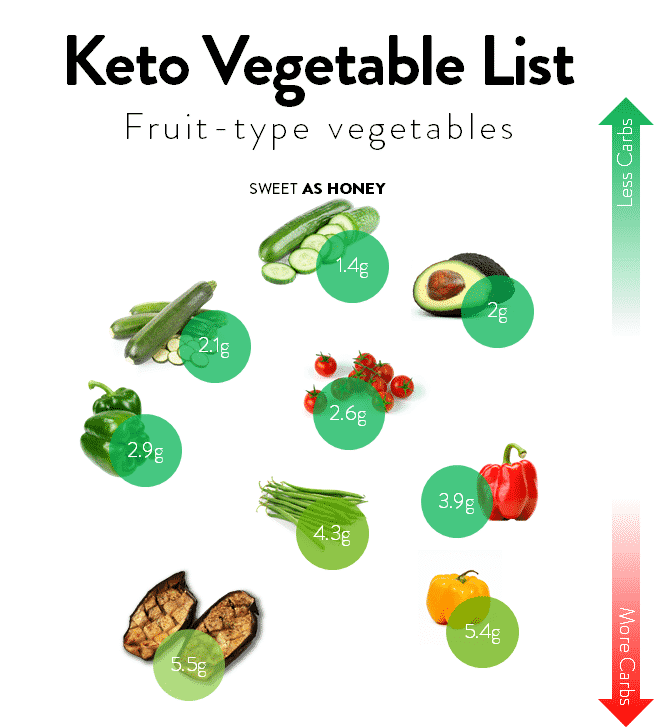
1. Olive (0.5g /100g)
Almost all the carbs present in olives are fibers. Therefore their net carbs are extremely low. On top of this, olives come most of the time marinated with oil, and therefore are a great low-carb-friendly vegetable!
Do you like olives? Check out my Keto Zucchini Pizza Casserole for a simple, comforting dish with Zucchini, Pepperoni, and of course, olives.
2. Cucumber (1.4g/100g – raw)
Since cucumbers belong to the Cucurbitaceae family (along with zucchini, pumpkin, watermelons, and many others), they are full of water and low in carbs.
The carbs in cucumber are as low as 2g/100g, so even with fivers as low as 0.7g/100g, cucumber is still on the keto-friendly podium of fruit vegetables.
3. Avocado (2g/100g – raw)
Avocados have a relatively high amount of carbs (9g/100g), but almost all of it is fibers. So it’s one of the best keto-friendly vegetables as it also contains a lot of good healthy fats.
I have many avocado recipes, but for a full avocado meal, try my Taco Stuffed Avocado followed by an Avocado Chocolate Cake.
4. Zucchini (2.1g/100g)
Zucchini belongs to the same Cucurbitaceae family as cucumbers – it’s also called summer squash.
They share a lot of very similar characteristics, and zucchinis are also an excellent keto vegetable.
Among my dozens of Zucchini recipes, my absolute favorite ones are the Zucchini Lasagna, the Zucchini Noodles, and my Zucchini Cake.
5. Tomato (2.6g/100g)
Tomatoes have the reputation of being a fruit – unlike the other fruit veggies on this low-carb-friendly vegetable list that are not widely known to be fruit.
Tomatoes are therefore often wrongly accused of not being keto-friendly. The reality is that their net carbs are very low!
Tomatoes are everywhere in my cuisine. Between tomato passata, tomato paste, or fresh tomatoes, there are many ways to use this vegetable to make anything from chicken curry to cheese cups.
6. Green Pepper (2.9g/100g)
Green peppers are the most keto-friendly kind of peppers. All three main colors of pepper (green, yellow, and red) have a similar amount of carbs but quite different levels of fiber.
I love the taste of green pepper, in particular in hearty dishes like a Keto Jambalaya or Keto Pizza Casserole.
7. Red Pepper (3.9g/100g)
Red bell peppers are very similar to the green ones but have a higher amount of carbs while having similar just a tad more fiber.
Despite having a little bit more carbs than green peppers, red peppers are still indispensable for making delicious keto dishes like a Zucchini Lasagna.
8. Pumpkin (4.0g/100g)
Pumpkin is one of the quite good vegetables on keto. With 5g/100g of fiber, it is good for your guts!
What’s incredible about pumpkin is that beyond the classic keto pumpkin pie, you can make anything from keto pumpkin bread to keto pumpkin pancakes, pumpkin cookies, or even pumpkin mousse!
9. Green Beans (4.3g/100g)
Green beans have 7 grams of carbs, and 2.7g of fiber, keeping the net carbs relatively low.
I love green beans, and my favorite recipe of all time has to be my Keto Green Bean Casserole. Even your non-keto friends will love it!
You can also try my Air Fryer Green Beans.
10. Yellow Pepper (5.4g/100g)
Yellow bell peppers have the highest net carb content of any of the bell peppers, topping 5.4g/100g. This is because its carb content is quite high while they are almost devoid of fiber.
11. Eggplant (5.5g/100g cooked, 3g/100g raw)
Eggplants are one of the vegetables that have their net carbs change a lot when cooking. It goes from 3g/100g raw to 5.5g/100g cooked. The increase comes from both a higher carb amount when cooked due to the evaporation of water and also a lower amount of fiber, decomposed by the cooking process.
Have you ever tried my keto pull-apart garlic “bread”? It’s delicious!
12. Spaghetti Squash (5.5g/100g)
Spaghetti Squash is a great keto-friendly vegetable. It’s relatively low in carbs, but it’s above all its spaghetti-like appearance that makes it a must-have for your pantry.
With a Spaghetti Squash, you can make my delicious spaghetti squash casserole or my Spaghetti Squash Keto Carbonara or just learn how to cook Spaghetti Squash.
13. Pumpkin (6g/100g)
Pumpkin is another relatively low-carb vegetable that you can use in many keto recipes. From Almond Flour Pumpkin Bread to a Keto Pumpkin Soup, or a Sugar-Free Pumpkin Spice Creamer Recipe, you can make everything with pumpkin.
You can even make your own pumpkin puree that you can freeze to make your favorite pumpkin recipes all year round!
14. Peas (9g/100g)
Peas are relatively high-carb vegetables. They are fine if you are on a low-carb diet, but if you are following the keto diet, you would have to take a small portion.
15. Butternut Squash (10g/100g)
Butternut Squash is quite a bit higher in carbohydrates than other squashes. As a result, you would use it only on a low-carb diet to avoid risking going out of ketosis!
Flower Vegetables
Some of the vegetables we consume are neither fruits, roots, nor leaves.
They are actually flowers or flower buds. Take broccoli, for example. If you look closely, you’ll see tiny flower buds.
These veggies are typically relatively low in carbs, but they also have relatively low amounts of fiber, keeping their net carbs on the green side of this low-carb-friendly vegetable list.
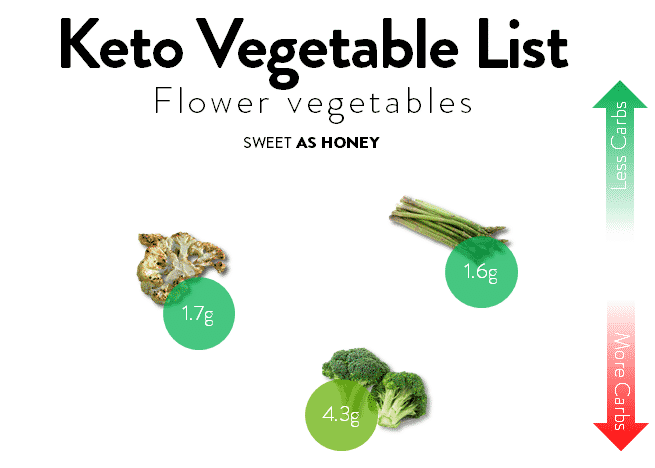
1. Asparagus (1.8g/100g)
Asparagus is actually more than just a flower bud, as we also eat the whole stem. They are low in carb, and low in fiber, making them an excellent Keto-friendly vegetable.
What better combination than Asparagus and Bacon? If you like those, try my Bacon-wrapped Asparagus recipe.
2. Cauliflower (3g/100g raw, 1.7g/100g cooked)
Cauliflower, unlike eggplants, is more keto-friendly when cooked. This comes from the fact that it’s normally cooked in water, increasing its water amount while also decomposing some of the carbs, and therefore decreasing its net carb amount.
Since cauliflower is so low-carb when cooked, it’s not a surprise to see it in so many recipes like my Keto Cauliflower Casserole, Steamed Cauliflower, Smoked Cauliflower, or my Keto Cauliflower Soup.
To eat Cauliflower in a refreshing and unusual way, try my Keto Cauliflower rice, my low-carb coconut rice, or a Cauliflower pizza crust.
3. Broccoli (4g/100g)
Despite coming from the same family, the broccoli doesn’t absorb as much water as the cauliflower, so its net carbs remain stable when boiled, at 4g/100g.
Whether it’s in a Keto Chicken Ranch Casserole or in Tater Tots, cauliflower is delicious and works well in keto recipes!
Leafy Vegetables
Leafy greens are all these vegetables that we mostly eat as leaves, like Spinach, Cabbage, Kale, or lettuce. They are all very good on a low-carb diet.
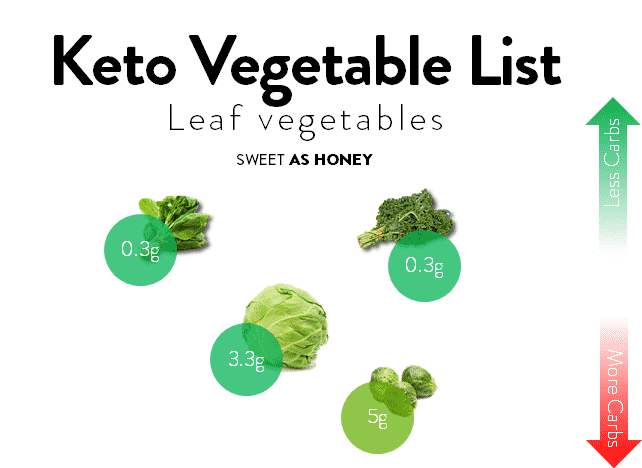
1. Kale (0.3g/100g)
Kale is an all-category winner of the keto vegetable list.
With almost all of the carbs being fiber, it’s perfectly compatible with a Keto diet. Kale is delicious in a salad or as Kale chips cooked in the oven or in an air fryer.
2. Spinach (1.4g/100g)
Spinach is a hit for bringing a lot of nutrients to your plate while keeping the carbs at bay.
With fibers almost making up all of the 3.6g of carbs in this leafy vegetable, spinach is topping the Keto-friendly vegetable list.
3. Cabbage (3.3g/100g)
Despite having almost 6g of carbs, cabbage is still a very keto-friendly vegetable because of its high amount of fiber.
4. Swiss Chard (3.7g/100g)
Swiss Chard has only 3.7 grams of net carbs, thanks to its high fiber content. It’s also one of the richest sources of Vitamin A and Vitamin K!
5. Brussels Sprouts (5g/100g)
Brussels sprouts have good fibers but relatively high carbs. That combination keeps this vegetable near the bottom of the above-the-ground vegetables for a low-carb diet.
I know that Brussels Sprouts have a bad reputation. Kids don’t like them. But give them my Mustard Brussels Sprouts, Oven Roasted Brussel Sprouts, Asian Brussel Sprouts, or Brussels Sprout Chips, and they will change their mind!
Under-The-Ground Vegetables
Under-the-ground vegetables have the particularity of being mostly used by plants as a way to store energy. They are starchy vegetables.
These veggies contain mostly polysaccharides, generally starch. They are therefore often quite high in carbs but lower in fiber, thus high-ish in net carbs.
The cooking method for under-the-ground vegetables often has an impact on net carbs!
Some of these are guaranteed to take you out of ketosis, while some others can still be consumed in low quantities.
And for some like radish, you can have many before you’re in trouble!
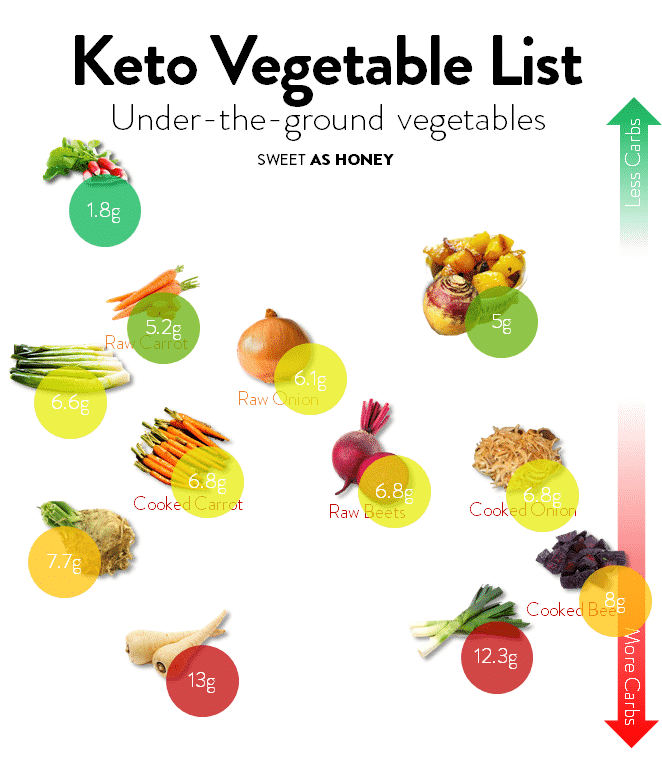
1. Radish (1.8g/100g raw/cooked)
Radish is a great Keto-friendly vegetable, raw or not.
2. Rutabaga (5g/100g boiled, 6.3g/100g raw)
This old-fashioned vegetable has the particularity of having less net carbs when cooking, but it’s right up there in net carbs – only take in small portions!
Try my Keto French Fries where the potatoes are replaced with Rutabaga for perfect keto-friendly fries!
3. Carrot (5.2g/100g boiled, 6.8g/100g raw)
Carrots also get better when boiled, but what out as it’s easy to eat too many of them. Small amounts only on a Keto diet!
My Carrot Taco Shells are the best way to enjoy Mexican food on a keto diet!
4. Onion (6.1g/100g cooked, 6.8g/100g raw)
Onions also have reduced net carbs after cooking.
Given that we tend to only eat a very small amount, it’s still fine to add onion to a large pot. Try to avoid in salads, though.
Nothing is more full of sweet onions than a French Onion Soup, and yet it’s perfectly keto-friendly, and it tastes delicious!
5. Leek (6.6g/100g boiled, 12.3g/100g raw)
Very few vegetables see their net carbs drop that significantly when cooked. Leeks almost lose half their carbs when boiled, so avoid eating them row.
Leek adds the perfect taste to any soup, even keto soups! Try my Keto Leek Cauliflower soup to be convinced!
6. Beetroot (6.8g/100g raw, 8g/100g cooked)
One of the few root vegetables that get worse when cooked is beetroot or beet. It’s OK-ish raw, but avoid it when cooked.
7. Celery Root (7.7g/100g raw/boiled)
Celery root, also called celeriac, is quite high in net carbs, both raw or cooked—one of the underground vegetables to avoid on a Keto diet or eat in very low amounts.
8. Potato (9.9g/100g raw, 18.8g/100g baked/boiled, 20.8g/100g fried)
Potatoes are not keto-friendly, unfortunately. But it’s useful to highlight that many places list the net carbs of raw potatoes, tricking you into thinking it’s almost OK.
But you are more likely to eat them baked, boiled, or fried, hitting close to your macros for the day with only 100g.
If you like the texture of potatoes, try my Cauliflower Potato Salad. No potato, but the same taste and texture.
9. Parsnip (13g/100g raw & cooked)
The net carbs in parsnips don’t change much with cooking, but they remain too high to be recommended on a keto diet.
10. Sweet Potato (15.2g/100g boiled, 17g/100g raw, 18.8g/100g baked, 30.3g/100g fried)
Sweet potatoes are here for illustration purposes as the net carbs vary drastically depending on how they are cooked. Net carbs drop a bit when boiled but increase slightly with oven-baking and sky-rocket with frying.
Sweet potatoes are sometimes seen as a healthy option. It is mostly because their Glycemic Load is much lower than the Glycemic Load of potatoes.
The Simple Rule Of Keto Vegetables
If it’s all too much information, remember the rule of thumb for your keto food list.
- Is it mostly a leaf? OK
- Is it a flower? OK
- Is it a fruit? Moderate
- Does it grow underground and can be eaten raw? Limited
- Does it grow underground and can’t be eaten raw? Avoid
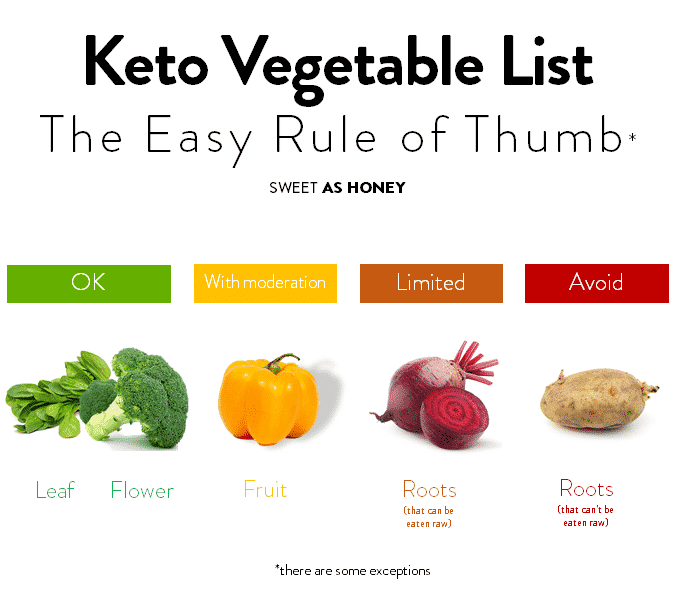
My Favorite Recipes With Keto-Friendly Vegetables
Now that you know which vegetables are best on Keto, these recipes might interest you!
Posted In:
Category:
ArticlesDisclaimer
The recipes, instructions, and articles on this website should not be taken or used as medical advice. The nutritional data provided on Sweetashoney is to be used as indicative only. The nutrition data is calculated using WP Recipe Maker. Net Carbs is calculated by removing the fiber and some sweeteners from the total Carbohydrates.
You should always calculate the nutritional data yourself instead of relying on Sweetashoney's data. Sweetashoney and its recipes and articles are not intended to cure, prevent, diagnose, or treat any disease. Sweetashoney cannot be liable for adverse reactions or any other outcome resulting from the use of recipes or advice found on the Website.
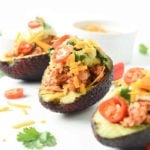

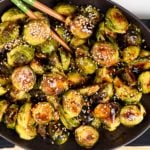






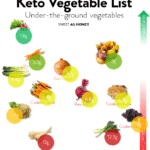
Share this post!
If you enjoyed this post, share it with your close ones!
Leave a comment
Very informative. Thank you
I’m curious about Keto and this is just wonderful reading I now have a much better understanding of what Keto is thank you soo much
Great info thank you, very detailed ane helpful.
Thank you!
This is extremely helpful information. Thank you!!